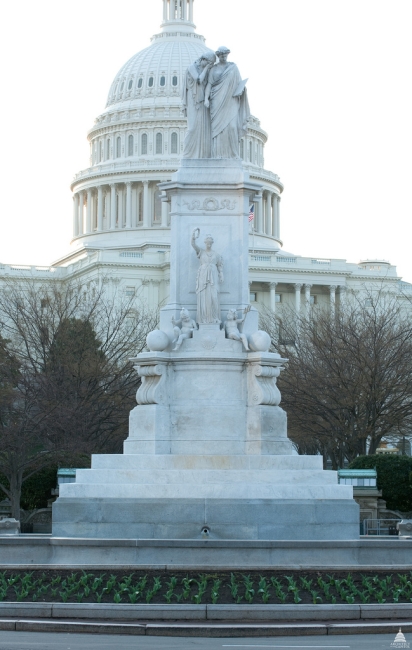You have /5 articles left.
Sign up for a free account or log in.

The Peace Monument
Architect of the Capitol
In the days after a mob stormed the U.S. Capitol building in an attempt to overturn the results of a fair and legal election, there was a brief flurry of interest in one of the Capitol complex’s lesser known statues: the 1878 Peace Monument. This statue, standing on the western side of the building at Pennsylvania Avenue and First Street NW, was sculpted by Franklin Simmons to commemorate naval deaths at sea during the U.S. Civil War.
Atop the monument are two female figures, both in classical robes. Grief weeps and rests her head on History’s shoulder. History, meanwhile, looks at the stylus and tablet she holds, inscribed with the words “They died that their country might live.” It is a cold comfort that History offers Grief in this statue, one predicated on the promise that events and people will not be forgotten in the future rather than connecting Grief to the past. In this statue, history’s work is future facing, not backward looking.
Historians have been in the position of providing context as well as offering comfort -- some sense that we have endured these kinds of crises in the past and come out the other side. Most historians were quick to point out that, in fact, the events at the Capitol on Jan. 6 were not unprecedented in world history (though, perhaps unsurprisingly, we could not agree on the relevant precedents). Throughout COVID-19, historians of medicine have reminded us that we are not experiencing the first, or even the deadliest, pandemic. Labor historians have explained that although this recession is unique in many respects, what working people are experiencing is the product of a series of decisions over generations. I take great personal comfort in knowing that “we are not alone across time” (to quote Bryan Doerries, founder of Theater of War). We turn to history during periods of grief because history holds us in a community of people who survived.
Despite that sense of continuity, it is not history’s primary job to provide comfort in times of crisis or solace in times of anxiety. Historians offer context and nuance in times when those things are in short supply, often asking us to check our assumptions and refine our critiques. Sometimes, that context can be comforting, but more often, it is uncomfortable because contextualization belies the comforts of precedent.
At its best, history asks us to face difficult, complex and sometimes conflicting truths and confront how those truths reverberate in the present. That can be enlightening and distressing at the same time. Many people will turn away from history when it challenges fundamental beliefs about a nation or a people. Or they will simply work to distort the historical record, cherry-picking evidence and interpretations that align with a specific worldview, often in order to create a legitimating precedent. When she appears as a truth teller, rather than a shoulder to cry on, History is much more difficult to love.
Of course, history is the product of historians. It is not a robed woman waiting to lecture us or prop us up; it is neither self-evident nor carved into stone. Instead, as explained in the American Historical Association’s Statement on Standards of Professional Conduct, “History is the never-ending process whereby people seek to understand the past and its many meanings.” It is through a “critical dialogue -- with each other, with the wider public, and with the historical record -- in which we explore former lives and diverse worlds in search of answers to the most compelling questions of our own time and place.”
After the last year, I might add that this critical dialogue also connects us to each other as individuals as much as professionals. When we turn toward our work as historians during a moment of crisis we are, in essence, turning toward this conversation. There is comfort in that.




